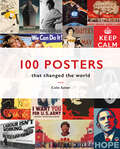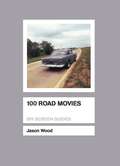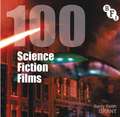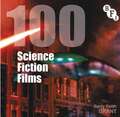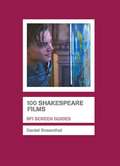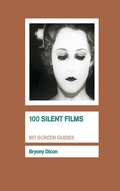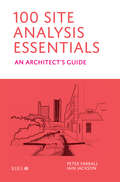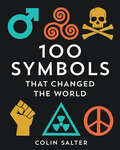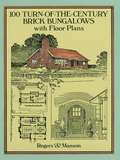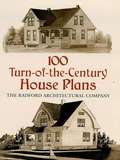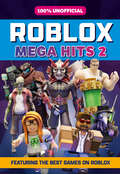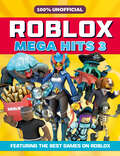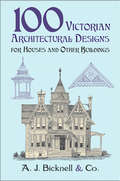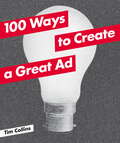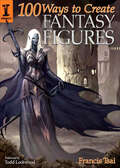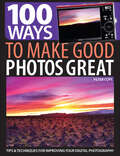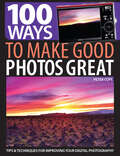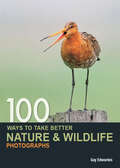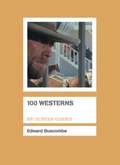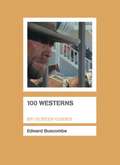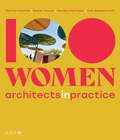- Table View
- List View
100 Posters That Changed The World
by Colin T. SalterA collection of the world's most memorable, provocative, best-selling and groundbreaking posters from Johannes Gutenberg to Barack Obama.
100 Road Movies (Screen Guides)
by Jason WoodIn '100 Road Movies', each entry will offer an insightful critique in terms of aesthetics, plot structure and defining formal and thematic features, whilst also considering the title in the wider context and understanding of by what criteria a film may be considered a road movie. Full credits, including year of production, principal cast and technical crew and country of origin will also be included at the foot of each entry. There will be a selection of illustrative stills, approximately twenty-five in total. The scope is broad, a consideration of the elements that gave rise to the road movie sub-genre, how this sub-genre corresponds to other traditional genres (the thriller, the western etc) and how various international countries have adopted the road movie to reflect their cultural, social, political and geographical identities.
100 Road Movies (Screen Guides)
by Jason WoodIn '100 Road Movies', each entry will offer an insightful critique in terms of aesthetics, plot structure and defining formal and thematic features, whilst also considering the title in the wider context and understanding of by what criteria a film may be considered a road movie. Full credits, including year of production, principal cast and technical crew and country of origin will also be included at the foot of each entry. There will be a selection of illustrative stills, approximately twenty-five in total. The scope is broad, a consideration of the elements that gave rise to the road movie sub-genre, how this sub-genre corresponds to other traditional genres (the thriller, the western etc) and how various international countries have adopted the road movie to reflect their cultural, social, political and geographical identities.
100 Science Fiction Films (Screen Guides)
by Barry Keith GrantA comprehensive guide to science fiction films, which analyzes and contextualizes the most important examples of the genre, from Un voyage dans la lune (1902), to The Road (2009).
100 Science Fiction Films (Screen Guides)
by Barry Keith GrantA comprehensive guide to science fiction films, which analyzes and contextualizes the most important examples of the genre, from Un voyage dans la lune (1902), to The Road (2009).
100 Shakespeare Films (Screen Guides)
by Daniel RosenthalFrom Oscar-winning British classics to Hollywood musicals and Westerns, from Soviet epics to Bollywood thrillers, Shakespeare has inspired an almost infinite variety of films. Directors as diverse as Orson Welles, Akira Kurosawa, Franco Zeffirelli, Kenneth Branagh, Baz Luhrmann and Julie Taymor have transferred Shakespeare's plays from stage to screen with unforgettable results. Spanning a century of cinema, from a silent short of 'The Tempest' (1907) to Kenneth Branagh's 'As You Like It' (2006), Daniel Rosenthal's up-to-date selection takes in the most important, inventive and unusual Shakespeare films ever made. Half are British and American productions that retain Shakespeare's language, including key works such as Olivier's 'Henry V' and 'Hamlet', Welles' 'Othello' and 'Chimes at Midnight', Branagh's 'Henry V' and 'Hamlet', Luhrmann's 'Romeo + Juliet' and Taymor's 'Titus'. Alongside these original-text films are more than 30 genre adaptations: titles that aim for a wider audience by using modernized dialogue and settings and customizing Shakespeare's plots and characters, transforming 'Macbeth' into a pistol-packing gangster ('Joe Macbeth' and 'Maqbool') or reimagining 'Othello' as a jazz musician ('All Night Long'). There are Shakesepeare-based Westerns ('Broken Lance', 'King of Texas'), musicals ('West Side Story', 'Kiss Me Kate'), high-school comedies ('10 Things I Hate About You', 'She's the Man'), even a sci-fi adventure ('Forbidden Planet'). There are also films dominated by the performance of a Shakespearean play ('In the Bleak Midwinter', 'Shakespeare in Love'). Rosenthal emphasises the global nature of Shakespearean cinema, with entries on more than 20 foreign-language titles, including Kurosawa's 'Throne of Blood and Ran', Grigori Kozintsev's 'Russian Hamlet' and 'King Lear', and little-known features from as far afield as 'Madagascar' and 'Venezuela', some never released in Britain or the US. He considers the films' production and box-office history and examines the film-makers' key interpretive decisions in comparison to their Shakespearean sources, focusing on cinematography, landscape, music, performance, production design, textual alterations and omissions. As cinema plays an increasingly important role in the study of Shakespeare at schools and universities, this is a wide-ranging, entertaining and accessible guide for Shakespeare teachers, students and enthusiasts.
100 Shakespeare Films (Screen Guides)
by Daniel RosenthalFrom Oscar-winning British classics to Hollywood musicals and Westerns, from Soviet epics to Bollywood thrillers, Shakespeare has inspired an almost infinite variety of films. Directors as diverse as Orson Welles, Akira Kurosawa, Franco Zeffirelli, Kenneth Branagh, Baz Luhrmann and Julie Taymor have transferred Shakespeare's plays from stage to screen with unforgettable results. Spanning a century of cinema, from a silent short of 'The Tempest' (1907) to Kenneth Branagh's 'As You Like It' (2006), Daniel Rosenthal's up-to-date selection takes in the most important, inventive and unusual Shakespeare films ever made. Half are British and American productions that retain Shakespeare's language, including key works such as Olivier's 'Henry V' and 'Hamlet', Welles' 'Othello' and 'Chimes at Midnight', Branagh's 'Henry V' and 'Hamlet', Luhrmann's 'Romeo + Juliet' and Taymor's 'Titus'. Alongside these original-text films are more than 30 genre adaptations: titles that aim for a wider audience by using modernized dialogue and settings and customizing Shakespeare's plots and characters, transforming 'Macbeth' into a pistol-packing gangster ('Joe Macbeth' and 'Maqbool') or reimagining 'Othello' as a jazz musician ('All Night Long'). There are Shakesepeare-based Westerns ('Broken Lance', 'King of Texas'), musicals ('West Side Story', 'Kiss Me Kate'), high-school comedies ('10 Things I Hate About You', 'She's the Man'), even a sci-fi adventure ('Forbidden Planet'). There are also films dominated by the performance of a Shakespearean play ('In the Bleak Midwinter', 'Shakespeare in Love'). Rosenthal emphasises the global nature of Shakespearean cinema, with entries on more than 20 foreign-language titles, including Kurosawa's 'Throne of Blood and Ran', Grigori Kozintsev's 'Russian Hamlet' and 'King Lear', and little-known features from as far afield as 'Madagascar' and 'Venezuela', some never released in Britain or the US. He considers the films' production and box-office history and examines the film-makers' key interpretive decisions in comparison to their Shakespearean sources, focusing on cinematography, landscape, music, performance, production design, textual alterations and omissions. As cinema plays an increasingly important role in the study of Shakespeare at schools and universities, this is a wide-ranging, entertaining and accessible guide for Shakespeare teachers, students and enthusiasts.
100 Silent Films (Screen Guides)
by Bryony Dixon100 Silent Films provides an authoritative and accessible history of silent cinema through one hundred of its most interesting and significant films. As Bryony Dixon contends, silent cinema is not a genre; it is the first 35 years of film history, a complex negotiation between art and commerce and a union of creativity and technology. At its most grand – on the big screen with a full orchestral accompaniment – it is magnificent, permitting a depth of emotional engagement rarely found in other fields of cinema. Silent film was hugely popular in its day, and its success enabled the development of large-scale film production in the United States and Europe. It was the start of our fascination with the moving image as a disseminator of information and as mass entertainment with its consequent celebrity culture. The digital revolution in the last few years and the restoration and reissue of archival treasures have contributed to a huge resurgence of interest in silent cinema. Bryony Dixon's illuminating guide introduces a wide range of films of the silent period (1895–1930), including classics such as The Birth of a Nation (1915), The General (1926), Metropolis (1927), Sunrise (1927) and Pandora's Box (1928), alongside more unexpected choices, and represents major genres and directors of the period – Griffith, Keaton, Chaplin, Murnau, Sjöström, Dovzhenko and Eisenstein – together with an introductory overview and useful filmographic and bibliographic information.
100 Site Analysis Essentials: An architect's guide
by Peter Farrall Iain JacksonHow do I follow a brief? What is the site’s context? What’s its history and what is adjacent to it now? How have other designers responded to similar site conditions? Conducting a site analysis is an essential part of the design process. Through careful examination, observation and documentation, you can cultivate a deeper understanding of the place you are designing. Designed to help students understand what a ‘site analysis’ is and why it is valuable to their design proposals, this book provides 100 easy-to-follow rules of thumb with simple line drawings and illustrations to help. Through a series of lenses, strategies and ideas, this book provides step-by-step guidance through the process to increase your understanding of a place and how to deliver the appropriate solution for your site. Supported by case studies with examples of tackling specific problems, you will develop the tools to explore, rationalise and convince others that your approach is right for the project.
100 Site Analysis Essentials: An architect's guide
by Peter Farrall Iain JacksonHow do I follow a brief? What is the site’s context? What’s its history and what is adjacent to it now? How have other designers responded to similar site conditions? Conducting a site analysis is an essential part of the design process. Through careful examination, observation and documentation, you can cultivate a deeper understanding of the place you are designing. Designed to help students understand what a ‘site analysis’ is and why it is valuable to their design proposals, this book provides 100 easy-to-follow rules of thumb with simple line drawings and illustrations to help. Through a series of lenses, strategies and ideas, this book provides step-by-step guidance through the process to increase your understanding of a place and how to deliver the appropriate solution for your site. Supported by case studies with examples of tackling specific problems, you will develop the tools to explore, rationalise and convince others that your approach is right for the project.
100 Symbols That Changed the World
by Colin Salter100 Symbols That Changed The World looks at the genesis and adoption of the world’s most recognizable symbols.
100 Turn-of-the-Century Brick Bungalows with Floor Plans
by Rogers MansonWhen Brickbuilder, an early 20th-century trade publication, sponsored a major nationwide competition for bungalow designs, over 600 drawings were submitted by architects and draftsmen from around the country. This book, reprinted from a rare catalog published in 1912, contains the 100 winning entries from that event. The competition had two important criteria: the principal construction material was to be brick, and the complete cost -- exclusive of the land -- would be about $3,000.The winning designs came from all over the United States and reflected a diverse range of tastes and styles -- from a single-floor, tile-roof hacienda to an elaborate thatched-roof English cottage, complete with decorative brickwork and a semicircular exterior wall. Each of the 100 superbly rendered plates shows the house in perspective and provides floor plans, some landscape planning, and an itemized list of construction costs.An essential reference book for restorers of period homes, historians, students, and enthusiasts of American domestic architecture, this fascinating book also offers browsers an entertaining glimpse of houses that still appear in countless areas across the country.
100 Turn-of-the-Century House Plans
by Radford Architectural Co.Affordable reprint of rare 1909 catalog, featuring authentic illustrations and floor plans for homes ranging from simple three-room bungalows to elaborate 10- and 12-room structures with sitting rooms, libraries, parlors, and wraparound porches. An excellent reference for home restorers, preservationists, and students of American architectural history. A delight for Americana fans and nostalgia lovers.
100% Unofficial Roblox Mega Hits 3
by 100% UnofficialOVER 15 MORE OF ROBLOX’S BEST GAMES INSIDE FOR YOU TO EXPLORE
100 Victorian Architectural Designs for Houses and Other Buildings (Dover Architecture)
by A. J. Bicknell Co.Originally published in 1878, this now-rare collection of designs supplies views of a remarkable variety of modestly priced structures: houses, villas, cottages, many others. Handsome drawings of perspective views and elevations, some of which include floor plans, plus suggestions for interior design. 98 black-and-white illustrations.
100 Ways to Create a Great Ad
by Tim Collins100 Ways to Create a Great Ad is an accessible introduction to creative advertising techniques. Featuring 100 spreads detailing concepts such as the "Reveal" and the "Mash-up", it presents the key methods of devising print, television, radio, direct, and online ideas. The process of creating an ad can be divided into three steps: planning; concept creation; crafting. This book provides a straightforward guide to concept creation, including methods that are applicable across media and offering wide-ranging examples from international campaigns. Aimed at agency creatives, planners, and account handlers, as well as graphic designers, marketing professionals, and students, 100 Ways to Create a Great Ad has wide-ranging appeal.
100 Ways To Create Fantasy Figures
by Francis Tsai100 exciting and ingenious ways to design and draw better fantasy figures - from developing characters to adding costumes, props and backdrops. Hollywood concept designer Francis Tsai shares tips and tricks for creating imaginative figures, giving readers a unique opportunity to gain guidance from a real pro.
100 Ways to Make Good Photos Great: Tips & Techniques for Improving Your Digital Photography
by Peter CopeA practical, accessible guide to turning your good photographs into great ones whether you are shooting on the latest digital SLR or a camera phone! Discover 100 simple and fun ways to improve your photographs both in-camera and through post-processing image manipulation. Every key photographic genre is covered, from perfect portraits and the great outdoors, to travel photos and shooting at night. Filled with inspirational examples of great photographs compared against the more average images, with easy to follow techniques for how you can achieve the same results. Whether you are an aspirational amateur wanting to make your photographs even better, or an enthusiastic beginner who just wants to produce more satisfying results, 100 Ways to Make Good Photographs Great will provide you with useful professional tips and techniques to take your photography to the next level.
100 Ways to Make Good Photos Great: Tips & Techniques for Improving Your Digital Photography
by Peter CopeA practical, accessible guide to turning your good photographs into great ones whether you are shooting on the latest digital SLR or a camera phone! Discover 100 simple and fun ways to improve your photographs both in-camera and through post-processing image manipulation. Every key photographic genre is covered, from perfect portraits and the great outdoors, to travel photos and shooting at night. Filled with inspirational examples of great photographs compared against the more average images, with easy to follow techniques for how you can achieve the same results. Whether you are an aspirational amateur wanting to make your photographs even better, or an enthusiastic beginner who just wants to produce more satisfying results, 100 Ways to Make Good Photographs Great will provide you with useful professional tips and techniques to take your photography to the next level.
100 Ways to Take Better Nature & Wildlife Photographs
by Guy EdwardesThis guide is suitable for all levels of photographers. 100 Ways to Take Better Nature and Wildlife Photographs features 100 practical and inspiring tips on every aspect of the genre. Guy Edwardes' breath-taking pictures accompany his eas-to-follow advice on a wide range of subjects from capturing the actions of large mammals to snapping wild birds and flowers in the garden.With tips on everything from technique to composition, coping with extreme field conditions to Photoshop software manipulation, this is an invaluable guide for anyone with a passion for photography of the natural world.
100 Westerns (Screen Guides)
by Edward BuscombeAddresses the perennial appeal of the Western, exploring its 19th century popular culture, and its relationship to the economic structure of Hollywood. This work considers the defining features of the Western and traces its main cycles, from the epic Westerns of the 1920s and singing cowboys of the 1930s to the Spaghetti Westerns of the 1960s.
100 Westerns (Screen Guides)
by Edward BuscombeAddresses the perennial appeal of the Western, exploring its 19th century popular culture, and its relationship to the economic structure of Hollywood. This work considers the defining features of the Western and traces its main cycles, from the epic Westerns of the 1920s and singing cowboys of the 1930s to the Spaghetti Westerns of the 1960s.
100 Women: Architects in Practice
by Harriet Harriss Naomi House Monika Parrinder Tom RavenscroftAll the architects in this book deserve international recognition. The reality is, though, that few are household names. Over the last decade, awareness of the need for gender balance in architecture has gained traction. Within the profession, women remain underrepresented, underpromoted and underpaid. Failure to acknowledge women’s contribution to the built environment has perpetuated this cycle and impoverished us all. By showcasing 100 exceptional architects – who happen to be women – this book provides a flagship reference to inspire and support everyone working in the profession, no matter how they identify. Global in outlook, the book presents an equitable sample of architects from every continent. We all need heroines as much as heroes. Through illustrated interviews, each woman shares how they are responding to a profound disconnect between architecture and the people and landscape it serves. Their visions, methods and models of leadership are essential to connecting the needs of humans and the planet. In the words of Indigenous Canadian architect Eladia Smoke: ‘Now is a critical time to seek out every opportunity to transmit this knowledge to future generations.’ Featuring: 100 interviews with leading women architects, including: Tatiana Bilbao, Odile Decq, Liz Diller, Julia Gamolina, Dorte Mandrup and Farshid Moussavi. Over 400 photographs and drawings. Geographically balanced selection, with profiles across every continent.
100 Women: Architects in Practice
by Harriet Harriss Naomi House Monika Parrinder Tom RavenscroftAll the architects in this book deserve international recognition. The reality is, though, that few are household names. Over the last decade, awareness of the need for gender balance in architecture has gained traction. Within the profession, women remain underrepresented, underpromoted and underpaid. Failure to acknowledge women’s contribution to the built environment has perpetuated this cycle and impoverished us all. By showcasing 100 exceptional architects – who happen to be women – this book provides a flagship reference to inspire and support everyone working in the profession, no matter how they identify. Global in outlook, the book presents an equitable sample of architects from every continent. We all need heroines as much as heroes. Through illustrated interviews, each woman shares how they are responding to a profound disconnect between architecture and the people and landscape it serves. Their visions, methods and models of leadership are essential to connecting the needs of humans and the planet. In the words of Indigenous Canadian architect Eladia Smoke: ‘Now is a critical time to seek out every opportunity to transmit this knowledge to future generations.’ Featuring: 100 interviews with leading women architects, including: Tatiana Bilbao, Odile Decq, Liz Diller, Julia Gamolina, Dorte Mandrup and Farshid Moussavi. Over 400 photographs and drawings. Geographically balanced selection, with profiles across every continent.
